Objectives and Key Results (OKRs) help you set goals and track their execution. While the Objective serves as an ambitious statement of our goal, the Key Results serve as metrics that track how we are doing toward achieving it.
An OKR software can help you visualize your organizational or team goal and its key results while tracking their progress. Modern OKR tools unlock company-wide transparency into strategic plans and align them with execution.
To help you make the best choice, we have selected, compared, and reviewed a list of the 14 best OKR software.
14 Best OKR Software
Needless to say, OKR software as a service solution (SaaS) is the fundamental trait of each modern OKR tool. Secured access from any remote location and instant updates are no longer enough. Outstanding OKR solutions provide enhanced visualizations, wide customization options, advanced OKRs tracking, analytics, integrations, and more.
Let’s look at the best 14 OKR software that are worth exploring.
1. Businessmap (formerly Kanbanize)
Businessmap is a Lean/Agile project portfolio management platform that can help you visualize objectives and key results on a shared kanban board to achieve greater alignment between strategy and execution. This happens by creating your high-level company or team goals as Initiatives and setting their key results to pursue as Outcomes.
 Visualization of key results’ progress using Outcomes in the software
Visualization of key results’ progress using Outcomes in the software
With the Businessmap's software, you can achieve transparency between goals, outcomes and specific work items contributing to the progress of each objective, visualize the dependencies between various teams and track all progress in a single place. The software offers an easy-to-navigate interface to help you implement OKRs.
 Objectives and key results' progress indicators
Objectives and key results' progress indicators
Features
- Wide OKRs customization options (values, properties, details)
- Visualize different outcome scenarios based on your goals
- Trends graph to measure the progress of key results
- Ability to add, edit, or delete historical data
- Outcome checkpoints
- Advanced integration options
- Free pre-recorded demo and live demo availability
2. Quantive
The orchestration system that Quantive has to offer includes employee success and OKR management features. The easy-to-use graphic interface with drag-and-drop functionality makes setting and connecting objectives and key results straightforward. The software allows you to set parent and child OKRs, and track their progress on your Home screen in real time. Features
Features
- OKR templates
- Easy-to-use sticky notes
- Owners and co-owners of OKRs
- Drag and drop alignment view of the OKR hierarchy structure
- Multiple reports – Insightboards
3. Perdoo
Perdoo’s goal management tool allows you to connect OKRs and KPIs in one place. Using an OKR roadmap, you can visualize how different levels of OKRs connect to each other. The software offers a view of the historical performance of company goals using strategic timelines and various reports. Features
Features
- OKR Roadmap
- Weekly progress reports
- Private OKRs and KPIs
- Growth board
- Data export and import
4. Weekdone
Weekdone OKR software puts results on display for the company. Thanks to visual dashboards, graphs, and views – leaders and employees always have eyes on the most important KPIs, metrics, trackable activities and weekly plans. Weekdone supports cross-team collaboration with open Newsfeed, OKR tracking, project updates, public feedback and praise to anyone in the company. Stay connected and encourage everyone to work toward company goals. Features
Features
- OKR hierarchy & company-wide linking
- Color-coded OKR and KPI progress dashboards
- Openly shared OKRs, Initiatives, and Weekly Plans
- Newsfeed to follow updates
- Automated weekly progress reports
- Public feedback and praise
- Team training and OKR coaching (included in cost)
5. Koan
Koan’s OKR platform offers straightforward visualization of measurable team goals. The software includes basic but fundamental functionalities, including real-time status updates, reflection insights, and feedback aiming to boost team alignment and collaboration.
Features
- Personal OKR and tracking of goals
- Company OKR dashboard
- Tracking OKRs of multiple teams
- OKR data export
6. Leapsome
Leapsome’s goals management solution allows you to visualize strategic plans and track their execution regardless of the goal-setting model you use. Leapsome creates a structure for your personal, team, or organizational goals visualizing ownership and internal dependencies.
Features
- Progress Timelines
- Automatic progress updates
- Feedback and praise opportunities
- Activity feed
- Goal analytics
7. ClickUp
A work management and OKR solution, ClickUp simplifies the organization of work and goals. Thanks to its board view feature, you can visualize the progress of each task in your workflow. Furthermore, you can create personal goals and targets to align with your company’s goals.
Features
- Customizable Goals and Targets
- Progress tracking
- Goals Folders
- Weekly Scorecards
8. Profit.co
Profit is a software solution that supports strategy execution through OKRs, task, and performance management. The goal-setting software uses a cascading style of objectives and key results visualization to help align everyone with the company goals. You can choose between different types of key results to indicate their completion more accurately. The software offers real-time insights into goals’ completion and performance at every organizational level.
Features
- Different types of key results
- Filtering and export functionalities
- Aligning multiple OKRs and connecting individual tasks to key results
- Comments, mentions, tags, status
- Automated reminders
9. Asana
Asana is a project management tool that allows you to organize your tasks, view them differently, automate tasks, and integrate with a number of other software programs. The OKR solution allows you to connect your work to your company goals in one place to monitor progress and keep everyone on track.
Features
- Goals and sub-goals
- Portfolio management
- Templates for company and team goals
- Integrations with Salesforce, Tableau, Power BI
10. 15Five
15five’s performance management and employee engagement solution allows you to focus on what matters with OKRs. You can set and track your objectives and share them with everyone across the organization.
Features
- Company-wide, departmental and personal OKRs
- Requesting feedback
- Weekly Check-Ins
- 1-on-1 goal reviews
More OKR Software
-
Oboard: Oboard is highly praised for its seamless integration capabilities, particularly within Jira environments, offering an efficient and effective service with a focus on transparency and client interests.
-
Synergita: Synergita excels in streamlining performance management processes with a user-friendly interface and continuous feedback mechanism.
-
OKRify: The AI-powered Salesforce app is designed to streamline the management of OKRs, KPIs, scorecards, contests, meetings, and employee recognition within the Salesforce platform where OKRs can be managed through a central hub.
-
Teamflect: The all-in-one performance management software is praised for its user-friendly interface and seamless integration with Microsoft Teams with strong collaboration and performance management features.
Regardless of your company, project, or team size, an OKR dashboard can help you share your plans and priorities. A well-designed OKR system can make all the difference by aligning everyone on the big picture and the overall direction your organization wants to take.
What Are the 4 Criteria for Comparing OKR Software?
The four key comparison criteria of а good OKR software include:
-
Enabling alignment with strategic plans.
-
Managing OKR dependencies and shared goals.
-
Creating review opportunities.
-
Tracking and measuring the progress of key results.
Let’s discover more.
1. Enable Alignment with The Strategic Plans
One of the key characteristics of the OKR goal-setting framework is the premise for a company-wide alignment of all efforts towards the same goals. With transparent goals reaching every team member, OKRs manage to spread the company’s strategic direction, incite proactive discussions, and drive employee engagement.
The OKR platform you choose should be apt to clearly visualize the key OKR attributes such as owner, time frame, objective, key results, progress indication, and make these available to every company member.
 Visualizing work alignment across different organizational levels
Visualizing work alignment across different organizational levels
2. Manage OKR Dependencies & Shared Goals
Dependencies and shared goals are part of the OKR framework. The transparency of OKR tools should show the organizational direction and how to get there through specific key results. For instance, the progress of the key results can be driven by the progress of various team initiatives or work items.
A good OKR software should allow you to establish dependencies between objectives (shared OKRs). For example, a team may have set 3 quarterly objectives whose execution needs to happen consecutively, or they depend on the OKRs of another team/business area within the company. It's important to visualize those connections to keep all stakeholders on the same page.
3. Create Review Opportunities
Objectives and key results enable focusing on what’s most important for your business. To address prioritization and achieve focused work, the framework promotes goals’ evaluation and encourages feedback.
Modern OKR platforms facilitate such evaluation through various customizable individual, team, or departmental reviews. Furthermore, OKR tooling systems provide multiple ways to submit feedback, comments, or reflections that can be addressed during meetings and discussions.
4. Tracking and Measure The Progress of Key Results
A cornerstone of the success of OKRs is measuring how you achieve the goals your team has set. Tracking the progress of your team goals shows if they are staying on track, including the ones falling behind.
Advanced OKR tools introduce functionalities such as score completion to indicate the progress of goals and real-time calculation of the results. Through visualization of goal completion, status messages, alerts, or automated notifications, OKR tools offer inventive ways to demonstrate how things are moving forward.
Free OKR Tools to Help with Goal Setting
Two of the best free OKR tools are Google Docs and Google Sheets. Google offers robust and complementary resources for monitoring OKRs. Employing Google Docs or Google Sheets presents a hassle-free and readily available approach to tracking your OKRs.
Leveraging Google's productivity suite, particularly Google Docs and Sheets presents a valuable opportunity for smaller teams. However, when seeking to implement objectives and key results (OKRs) across a larger enterprise, it might be necessary to consider investing in paid OKR software tool. Such tools can provide robust functionality and scalability to support the multifaceted needs of a more extensive organization.
What Are the Benefits of OKR Software?
Various software tools have been developed to help streamline and manage OKRs. One of the main benefits of OKR software is that they help organizations to maintain focus and accountability. OKR tools allow teams to set and monitor their goals, communicate progress, and stay on track.
Additionally, OKR software tools provide valuable insights into company performance, identifying areas that need improvement and highlighting achievements. They can help analyze trends and evaluate the effectiveness of the OKR program. Furthermore, OKR software can help to promote transparency and increase employee engagement.
OKR software can help organizations align their goals and objectives with their overall strategy.
One of the foremost benefits of OKR software is that they help organizations align their goals and objectives with their overall strategy. OKR tools provide a framework for defining and tracking objectives, aligning them with key results, and then measuring progress toward those goals.
By using OKRs, organizations can prioritize their initiatives and actions to ensure that every aspect of the business is working towards the same goals. This alignment of goals and objectives helps to increase efficiency, reduce redundancies, and ultimately improve the organization's overall productivity.
Additionally, OKR software tools provide real-time analytics and reports, enabling teams to identify roadblocks and make necessary adjustments, thus ensuring that everyone is on track to achieving their targets.
OKR tools can facilitate communication and collaboration among team members, improving overall productivity and efficiency.
When it comes to boosting productivity and efficiency in a team, implementing OKR software can offer a range of benefits. One of the key advantages of these tools is facilitating communication and collaboration among team members. This can be achieved through features such as real-time updates, progress tracking, and easy access to shared objectives and key results.
Team members can quickly and easily interact with one another, exchange ideas and feedback, and stay on the same page regarding their goals and priorities. As a result, teams can achieve greater clarity, alignment, and coordination, leading to improved overall productivity and efficiency.
By providing real-time progress tracking and analytics, OKR software enable organizations to make data-driven decisions and adjustments as needed.
One of the significant benefits of OKR software is that they provide real-time progress tracking and analytics. This helps organizations make data-driven decisions and adjustments as needed. With the help of real-time analytics, teams can easily track their progress toward their goals, see how well they are performing, and determine the areas that need improvement.
OKR software provide a holistic view of team progress, including individual team members' contributions, making evaluating contributions to the overall goal easier.
OKR software can also help organizations identify and prioritize high-impact projects, leading to improved outcomes and increased revenue.
The benefits of OKR software are numerous, with one of the most important being their ability to help organizations identify and prioritize high-impact projects. By providing a straightforward way for teams to set and track their objectives and key results, OKR software allows for greater transparency and alignment across departments.
This, in turn, can lead to improved outcomes and increased revenue, as teams can better focus their efforts on the most important initiatives. Additionally, OKR software tools can promote a culture of continuous improvement and accountability, which is particularly valuable for organizations looking to stay competitive and adapt to changing market conditions.
Finally, OKR software can help organizations create a culture of transparency and accountability, improving employee engagement and retention.
OKR software can help organizations foster a culture of transparency and accountability. With the help of OKR tools, companies can easily set and track progress toward their objectives. This transparency can create a sense of ownership and accountability among employees, who can quickly see how their efforts contribute to the company's success. Additionally, when employees understand how their work contributes to the company's goals, they are more engaged and motivated to perform, ultimately leading to improved retention rates.
OKR Software Frequently Asked Questions (FAQ)
What Is OKR Software?
OKR software is a tool that organizations use to implement the OKR (Objectives and Key Results) goal-setting framework. It allows teams and individuals to set goals, track progress, and measure success in achieving objectives and key results.
The software typically includes features like goal-setting templates, progress-tracking dashboards, real-time reporting, and collaboration tools to help teams work together towards shared goals.
Who Needs an OKR Software?
OKR software is helpful for any organization, team, or individual who wants to set and track goals effectively. It can particularly benefit businesses, startups, nonprofits, and remote teams that must align their objectives and key results across different departments or locations.
However, anyone who wants to improve their goal-setting and performance management can benefit from using OKR software.
Why Should My Organization Use OKR Software?
Your organization should use OKR software for several reasons:
-
Alignment: OKR software enables your team to align their individual goals with the company's larger objectives, ensuring everyone works towards a common goal.
-
Transparency: With OKR software, progress towards goals is easily visible to everyone, promoting transparency and accountability.
-
Easy tracking: OKR software makes it easy to track progress toward goals and identify areas that need improvement.
-
Continuous improvement: OKR software allows your team to review progress regularly and adjust goals, leading to continuous improvement and adaptation.
-
Improved communication: Using OKR software improves communication between team members and management, leading to better collaboration and a more efficient workflow.
Is OKR a Performance Management Tool?
No, OKR (Objectives and Key Results) is a goal-setting framework. While both are used to manage and improve performance, there are some clear differences between OKRs and the performance management evaluation process. OKRs can help organizations set and track goals, measure progress, and align individual and team efforts with the organization's overall strategy. In comparison, the performance management process aims to evaluate individual, team, or company performance, and it's often directly tied to compensation, bonus, and promotions.
How to Choose the Right OKR Tool?
When choosing an OKR tooling, you should get buy-in from the majority and adhere to the chosen platform on all levels. Here's an overview of the capabilities an OKR solution should provide you with.
Step 1: Set and visualize all OKRs.
Step 2: Ensure that OKRs are linked across teams and departments in the company.
Step 3: Monitor and track OKRs on the same platform.
Step 4: Select cadences frequency for goals evaluation on each organizational level.
Step 5: Review and assess OKRs based on analytics and reports available in the OKR software.
We offer the most flexible software platform
for outcome-driven enterprise agility.
Related Articles





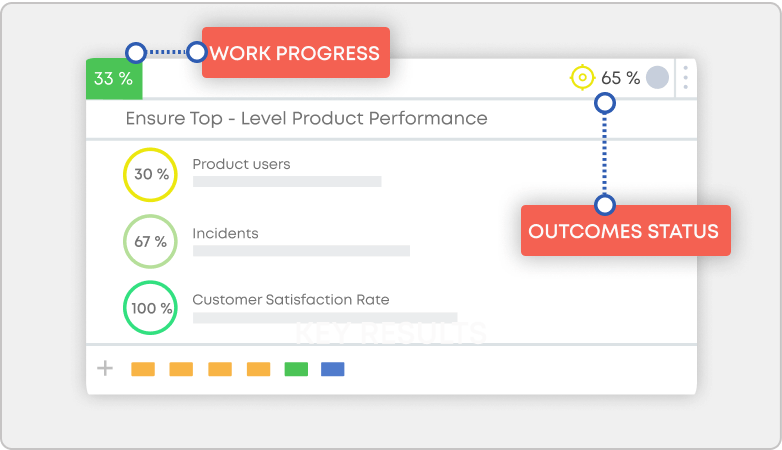 Objectives and key results' progress indicators
Objectives and key results' progress indicators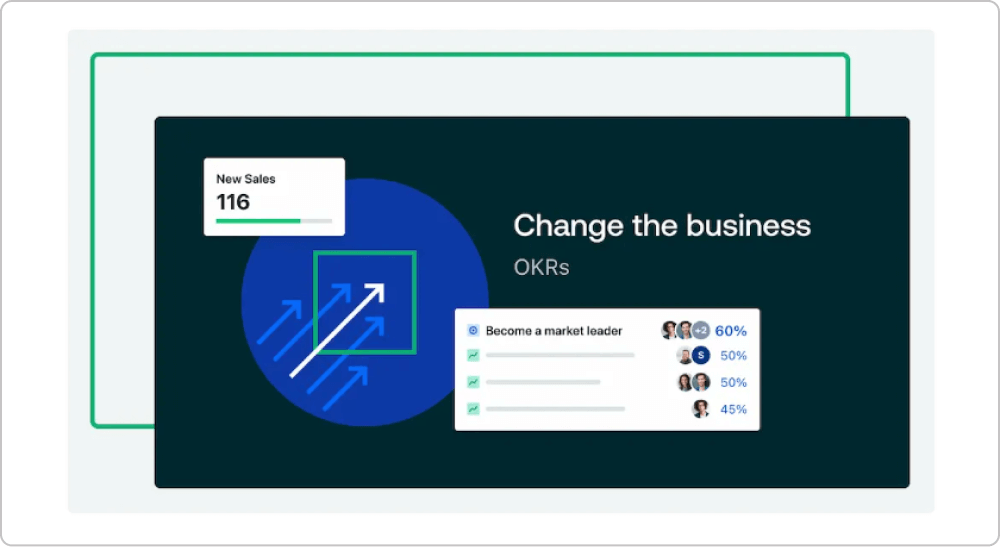 Features
Features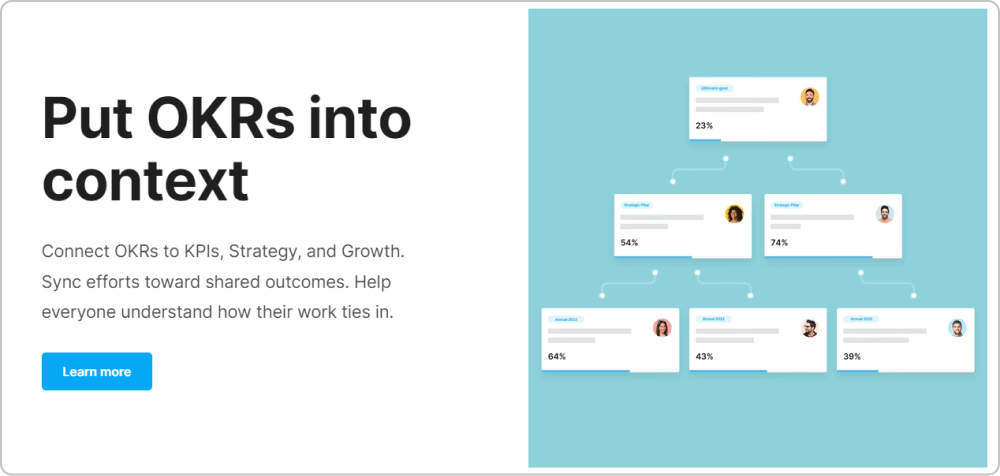 Features
Features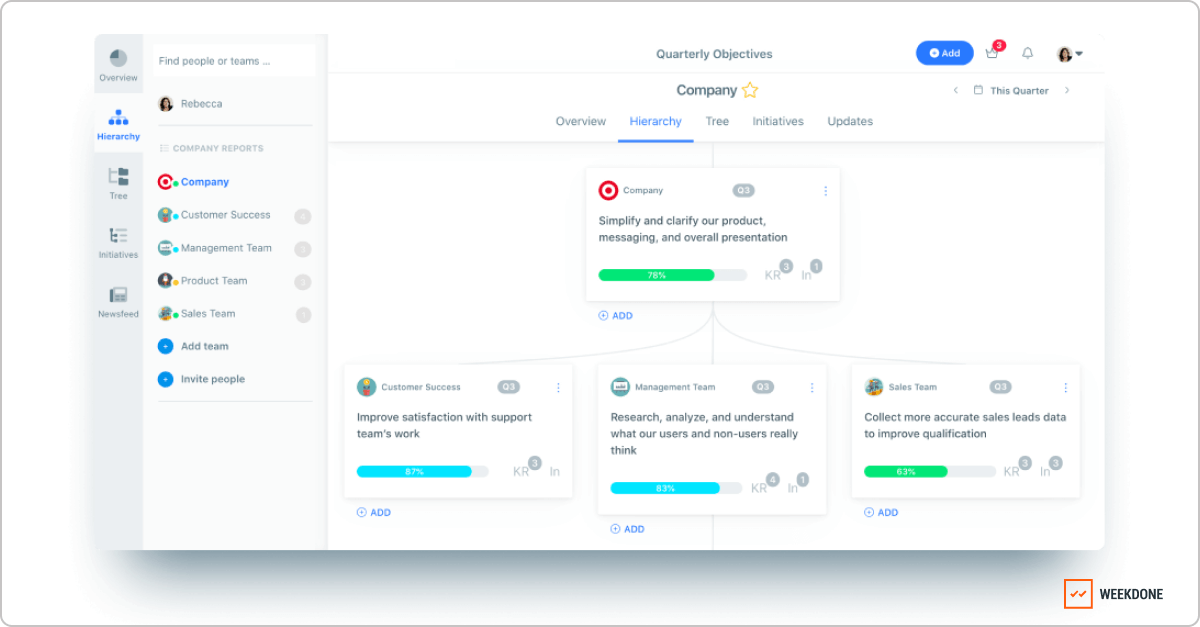 Features
Features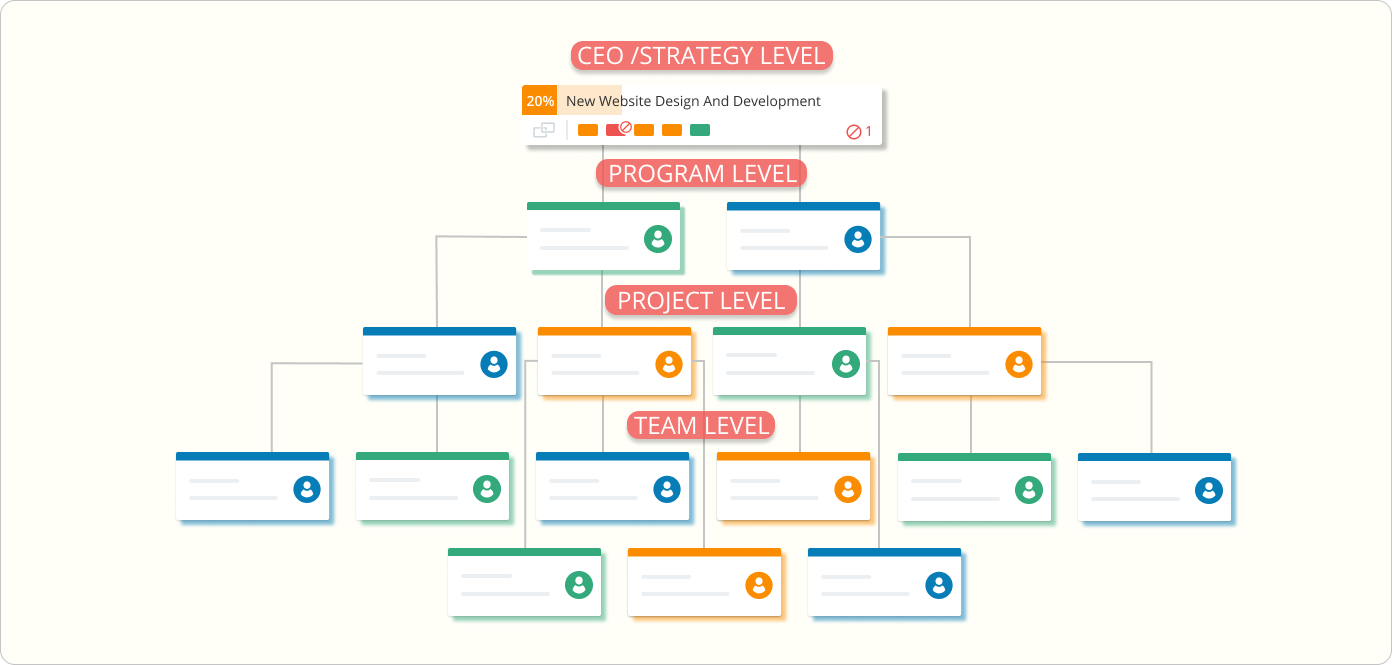 Visualizing work alignment across different organizational levels
Visualizing work alignment across different organizational levels

